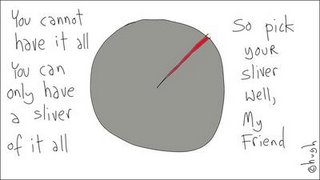 This "Innovation Self-Diagnostic test" might be a good conversation starter about your company's ability to foster and capitalize on innovation initiatives.
This "Innovation Self-Diagnostic test" might be a good conversation starter about your company's ability to foster and capitalize on innovation initiatives.http://bwnt.businessweek.com/self_diagnostic/quiz.asp
 This "Innovation Self-Diagnostic test" might be a good conversation starter about your company's ability to foster and capitalize on innovation initiatives.
This "Innovation Self-Diagnostic test" might be a good conversation starter about your company's ability to foster and capitalize on innovation initiatives.
There are businesses that have been working the tailing end of markets, including the brands mentioned above like NetFlix, Rhapsody, and Amazon. The applications of this are far reaching. Blogging is the long tail of web publishing. Terrorism is the long tail of war. Examples of the long tail are everywhere and although the concept is not new, it is a strategy that many now are embracing as new technology has enabled growth without traditional inventory models, distribution expenses, or mass production costs. The examples of the long tail of product-based business is interesting and worthy of discussion. How could your business expand to include the long tail of the markets you serve? However, my interest in sharing this today is how the theory of the long tail could change how services are delivered.
By their very nature, services are more personal. They are generally not sold through mass distribution channels. They are contract-based. However, I see a lot of opportunity for services companies to use technology to reach the long tail of their market. Or better yet, could a product company get into the services business by thinking about the long tail of their marketplace. One example of this is in the stationary business.
There are over 4,000 Hallmark Gold Crown Stores. American Greetings are sold in thousands of outlets. Crane & Co stores are in dozens of cities. For those who love paper (as I do), it is exciting to see the selection, feel the textures of offerings, and dream of a lifestyle of leisure where I would sit down daily at a writing desk with quill pen in hand to craft gracious notes of appreciation and sympathy. Instead, like millions of Americans, I scribble out the periodic note or special occassion card and rely on email for more pedestrian communications. Right now, my address book is in Plaxo, cards are available at the store (or I suppose I could print out my own on the computer), stamps are available at a variety of outlets, and the trigger for correspondence is varied. They can range from a birthday scribbled on a calendar, to a phone call or email, or to a thought that I might have about an old friend. How could this industry respond to the long tail of correspondence and provide more than just the standard selection of greeting cards in retail outlets?
Imagine if a service was available that look my address book (and the birthdays recorded there) and I could specify automatic printed cards to be sent. (Plaxo has an ecard offering, but you have to manually select and remember to send them.) They would do the addressing, stamping and mailing. If I wanted to personalize the message, a prompt would be sent to me via email asking for the message in time for them to print the card and get it in the mail. Since they are printed on demand, they could offer a wider selection of card design, graphics, and copy. Furthermore, they could accept original artwork or copy that I provided to them. (Today, I can submit a digital photo, for instance, and get cards made at PSPrint, 48hourprint, iprint, Zazzle, and others, but they are not tied into my address book). If the interface was slick, they could take a page from Zazzle's playbook and make my card available to others for selection (giving me a cut of the profits). I could customize this service with the alerts, control, payment options, or expense level that I would specify. The holidays would be a great time to test this system out and then let the long tail of correspondence lead to birthdays, sympathy cards, and "thinking of you" cards throughout the year.
So, it sounds cool, but would you use a system like this?
 Getting "unstuck" is the term used to describe when we take action beyond perceived constraints and free our minds to see possibilities. I love this idea, because is exudes positivity and possibility (two of my favorite things).
Getting "unstuck" is the term used to describe when we take action beyond perceived constraints and free our minds to see possibilities. I love this idea, because is exudes positivity and possibility (two of my favorite things).
 You may have heard about this, and it is worth repeating. Architect Mike Pearce was given a complex challenge on a project in Zimbabwe. He was asked to build an office building that would be comfortable without air conditioning! The result: Eastgate, a mixed office comoplex and shopping mall covering half a city block in the business center of Harare, Zimbabwe. How did he do it? By studying termite mounds, which are able to maintain a constant temperature dispite ambient temperature swings ranging from 35 to 104 degrees. You can find out more about how it works at Wikipedia entry. Fascinating!
You may have heard about this, and it is worth repeating. Architect Mike Pearce was given a complex challenge on a project in Zimbabwe. He was asked to build an office building that would be comfortable without air conditioning! The result: Eastgate, a mixed office comoplex and shopping mall covering half a city block in the business center of Harare, Zimbabwe. How did he do it? By studying termite mounds, which are able to maintain a constant temperature dispite ambient temperature swings ranging from 35 to 104 degrees. You can find out more about how it works at Wikipedia entry. Fascinating!In Patrick Lencioni's book The Five Temptations of a CEO (which is a great one, by the way), he warns business leaders to never confuse clarity with certainty. There are always things that are uncertain. Facts that require validation. Assumptions that need to be checked out. Assumptions that must be researched.
That uncertainty can't stop people from being clear in their communications. Better to say "here is what I know and here is what I don't know" and "here is what we are going to do," than say "I think we should do this." It is important in all of our communications that we model clarity, even if there are things about which we are uncertain. Better yet, if you feel like you can't be clear or certain in your communications, stop and take action immediately to resolve the issue. Once you find the answer or have taken appropriate action, then respond.
Note: sometimes this approach will require you to respond with a "I have heard you and will respond when I have a chance to give it proper attention". Especially if the request came via email, where people expect responses.
If you want to purchase a copy of Patrick's book--which is an easy, but insightful read-- click below.
The Five Temptations of a CEO: A Leadership Fable
 Sometimes my brain kicks into overdrive and spews out more ideas than I could possibly take action on, so rather than let them go to waste, I thought I would recycle them. Literally.
Sometimes my brain kicks into overdrive and spews out more ideas than I could possibly take action on, so rather than let them go to waste, I thought I would recycle them. Literally. © Innovative Business, Remarkable Tributes, Inc.
Blog template by FalconHive | Blog Templates Sponsored by Blogger Styles
© Innovative Business, Remarkable Tributes, Inc.
Blog template by FalconHive | Blog Templates Sponsored by Blogger Styles